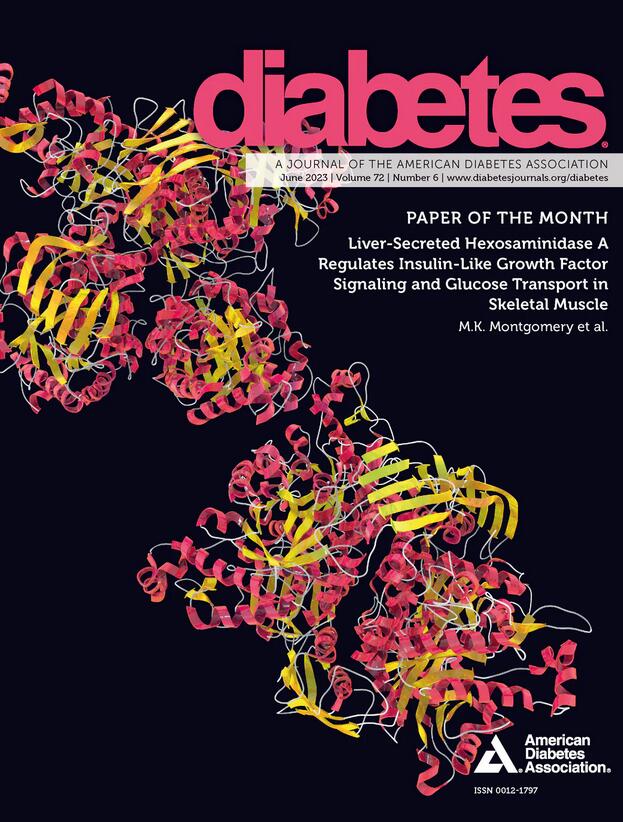344-OR: MOTS-c/CK2 通路是东亚人 2 型糖尿病的新分子靶点
IF 6.2
1区 医学
Q1 ENDOCRINOLOGY & METABOLISM
引用次数: 0
摘要
引言和目的:MOTS-c是一种线粒体DNA编码的微量蛋白,能改善因衰老和高脂肪饮食导致的葡萄糖代谢障碍。MOTS-c的一个天然遗传变异K14Q MOTS-c会增加东亚人对2型糖尿病(T2D)的易感性。然而,MOTS-c 的确切作用机制尚未完全阐明。在这里,我们证明了蛋白激酶 CK2 是 MOTS-c 的一个功能性直接靶标,K14Q MOTS-c 与 CK2 的结合减少会增加 T2D 的风险。研究方法我们进行了体外实验,包括点印迹、激酶活性和表面等离子体共振测定,以研究 MOTS-c 与 CK2 之间的直接相互作用。我们还研究了 MOTS-c 处理对骨骼肌中 CK2 活性的影响,以及对幼鼠肌肉葡萄糖摄取的影响。随后,我们研究了自然发生的 K14Q MOTS-c 变异对 12068 名日本人 T2D 患病率的影响。研究结果点印迹和无细胞激酶活性测定表明,MOTS-c 通过直接与其 α 亚基结合来激活 CK2,这种结合通过表面等离子体共振测定得到了证实。重要的是,K14Q MOTS-c 与 CK2α 的结合亲和力是野生型 MOTS-c 的 16 倍,而且在无细胞激酶活性测定中,K14Q MOTS-c 没有激活 CK2。老龄小鼠的骨骼肌 CK2 活性较低,运动后较高,服用 MOTS-c 可提高骨骼肌 CK2 活性,但 K14Q MOTS-c 不能。服用 MOTS-c(而非 K14Q MOTS-c)能显著提高肌肉的葡萄糖摄取量,而 CK2 抑制剂则会减弱肌肉的葡萄糖摄取量。在人体中,K14Q MOTS-c 携带者罹患 2 型糖尿病的风险增加,尤其是在 60 岁及以上的人群中,而日常体育锻炼可减轻这种风险的增加。结论这些发现共同证明,MOTS-c 的作用需要 CK2,MOTS-c/CK2 途径是治疗 T2D 的潜在靶点:无。S. Kim:无。B. Miller:B. Miller: None.S. Lee: None.H. Zempo:无。T. Natsume无。J. Wan:无。R. Ramirez II: None.H.H. Mehta:无。Y. Nishida: None.N. Fuku:N. Fuku: None.S. Dobashi:无。E. Miyamoto-Mikami: None.H. Naito:无。M. Hara:无。C. Iwasaka:C. Iwasaka: None.Y. Yamada: None.Y. Higaki: None.K. Tanaka:K. Tanaka: None.K. Yen:无。P. Cohen:无。本文章由计算机程序翻译,如有差异,请以英文原文为准。
344-OR: The MOTS-c/CK2 Pathway Is a Novel Molecular Target for Type 2 Diabetes in East Asians
Introduction & Objective: MOTS-c is a mitochondrial DNA-encoded microprotein that improves impaired glucose metabolism caused by aging and high fat diet. The presence of a naturally occurring genetic variant of MOTS-c, K14Q MOTS-c, increases the susceptibility to type 2 diabetes (T2D) in East Asians. Nevertheless, the precise mechanism of MOTS-c action has not been fully elucidated. Here, we demonstrate that the protein kinase CK2 is a functional and direct target of MOTS-c and that the reduced binding of K14Q MOTS-c to CK2 increases the risk of T2D. Methods: We performed in vitro experiments, including dot blot, kinase activity, and surface plasmon resonance assays, to investigate the direct interaction between MOTS-c and CK2. We also examined the impact of MOTS-c treatment on CK2 activity in skeletal muscle, as well as on muscle glucose uptake in young mice. Subsequently, we investigated the impact of a naturally occurring K14Q MOTS-c variant on the prevalence of T2D in 12,068 Japanese individuals. Results: Dot blot and cell-free kinase activity assays demonstrated that MOTS-c activated CK2 by binding directly to its α subunit, and this binding was confirmed using a surface plasmon resonance assay. Importantly, the binding affinity of K14Q MOTS-c to CK2α was 16-fold less than that of the wild type MOTS-c, and K14Q MOTS-c did not activate CK2 in the cell-free kinase activity assay. Skeletal muscle CK2 activity was lower in old mice and higher after exercise, and was increased by MOTS-c administration, but not K14Q MOTS-c. MOTS-c administration, but not K14Q MOTS-c, significantly enhanced muscle glucose uptake, which was blunted by a CK2 inhibitor. In humans, the K14Q MOTS-c carriers exhibited an increased risk of type 2 diabetes, particularly among individuals aged 60 and above, while this increased risk was mitigated by daily physical activity. Conclusion: Together, these findings provide evidence that CK2 is required for MOTS-c effects and that the MOTS-c/CK2 pathway is a potential therapeutic target for T2D.<u></u> Disclosure H. Kumagai: None. S. Kim: None. B. Miller: None. S. Lee: None. H. Zempo: None. T. Natsume: None. J. Wan: None. R. Ramirez II: None. H.H. Mehta: None. Y. Nishida: None. N. Fuku: None. S. Dobashi: None. E. Miyamoto-Mikami: None. H. Naito: None. M. Hara: None. C. Iwasaka: None. Y. Yamada: None. Y. Higaki: None. K. Tanaka: None. K. Yen: None. P. Cohen: None.
求助全文
通过发布文献求助,成功后即可免费获取论文全文。
去求助
来源期刊

Diabetes
医学-内分泌学与代谢
CiteScore
12.50
自引率
2.60%
发文量
1968
审稿时长
1 months
期刊介绍:
Diabetes is a scientific journal that publishes original research exploring the physiological and pathophysiological aspects of diabetes mellitus. We encourage submissions of manuscripts pertaining to laboratory, animal, or human research, covering a wide range of topics. Our primary focus is on investigative reports investigating various aspects such as the development and progression of diabetes, along with its associated complications. We also welcome studies delving into normal and pathological pancreatic islet function and intermediary metabolism, as well as exploring the mechanisms of drug and hormone action from a pharmacological perspective. Additionally, we encourage submissions that delve into the biochemical and molecular aspects of both normal and abnormal biological processes.
However, it is important to note that we do not publish studies relating to diabetes education or the application of accepted therapeutic and diagnostic approaches to patients with diabetes mellitus. Our aim is to provide a platform for research that contributes to advancing our understanding of the underlying mechanisms and processes of diabetes.
 求助内容:
求助内容: 应助结果提醒方式:
应助结果提醒方式:


